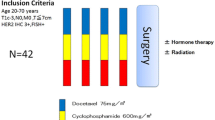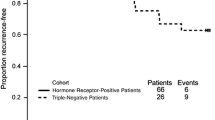Abstract
An addition of trastuzumab preoperatively to chemotherapy for human epidermal growth factor receptor 2 (HER2) positive breast cancer improved relapse-free survival (RFS). This study was designed to evaluate the efficacy and safety of preoperative paclitaxel, gemcitabine, and trastuzumab (PGH) combination for HER2-positive breast caner. Pathologically, proven node positive stage II/III breast cancer patients with adequate organ function and no history of anti-cancer therapy were eligible. Patients received weekly trastuzumab with paclitaxel 80 mg/m2 and gemcitabine 1,200 mg/m2 on days 1 and 8, every 3 weeks for 6 cycles. Postoperatively, patients completed trastuzumab for 1 year and hormone therapy for 5 years if indicated. All patients received postoperative radiation therapy. Of 53 enrolled patients with a median tumor of 5.3 (range, 2.0 to >12) cm; 43.4%, T3/T4; 75.4%, N2/N3; and 45.3%, positive hormone receptors. The pathologic complete response (pCR) rate was 58.5% in both tumor and lymph nodes. Grade 3/4 adverse events were neutropenia (32%), febrile neutropenia (0.6%), and transient elevation of AST/ALT (1.6%) during a total of 318 cycles. All patients maintained normal cardiac function. With a median follow-up of 40 months, 3-year RFS rate was 84% with 91.7% distant metastasis-free survival rates. Remarkable pCR rate was obtained with non-anthracycline-based PGH therapy for HER2-positive stage II/III breast cancer. Adverse events were mild with few incidences of febrile neutropenia.


Similar content being viewed by others
References
Gusterson BA, Gelber RD, Goldhirsch A et al (1992) Prognostic importance of c-erbB-2 expression in breast cancer. International (Ludwig) Breast Cancer Study Group. J Clin Oncol 10:1049–1056
Slamon DJ, Clark GM, Wong SG et al (1987) Human breast cancer: correlation of relapse and survival with amplification of the HER-2/neu oncogene. Science 235:177–182
Slamon DJ, Leyland-Jones B, Shak S et al (2001) Use of chemotherapy plus a monoclonal antibody against HER2 for metastatic breast cancer that overexpresses HER2. N Engl J Med 344:783–792
Romond EH, Perez EA, Bryant J et al (2005) Trastuzumab plus adjuvant chemotherapy for operable HER2-positive breast cancer. N Engl J Med 353:1673–1684
Campone M, Roche H, Kerbrat P et al (2005) Secondary leukemia after epirubicin-based adjuvant chemotherapy in operable breast cancer patients: 16 years experience of the French Adjuvant Study Group. Ann Oncol 16:1343–1351
Fumoleau P, Roche H, Kerbrat P et al (2006) Long-term cardiac toxicity after adjuvant epirubicin-based chemotherapy in early breast cancer: French Adjuvant Study Group results. Ann Oncol 17:85–92
Crump M, Tu D, Shepherd L et al (2003) Risk of acute leukemia following epirubicin-based adjuvant chemotherapy: a report from the National Cancer Institute of Canada Clinical Trials Group. J Clin Oncol 21:3066–3071
Bernard-Marty C, Mano M, Paesmans M et al (2003) Second malignancies following adjuvant chemotherapy: 6-year results from a Belgian randomized study comparing cyclophosphamide, methotrexate and 5-fluorouracil (CMF) with an anthracycline-based regimen in adjuvant treatment of node-positive breast cancer patients. Ann Oncol 14:693–698
Perez EA, Suman VJ, Davidson NE et al (2008) Cardiac safety analysis of doxorubicin and cyclophosphamide followed by paclitaxel with or without trastuzumab in the North Central Cancer Treatment Group N9831 adjuvant breast cancer trial. J Clin Oncol 26:1231–1238
Jones S, Holmes FA, O’Shaughnessy J et al (2009) Docetaxel with cyclophosphamide is associated with an overall survival benefit compared with doxorubicin and cyclophosphamide: 7-year follow-up of US Oncology Research Trial 9735. J Clin Oncol 27:1177–1183
Jones SE, Savin MA, Holmes FA et al (2006) Phase III trial comparing doxorubicin plus cyclophosphamide with docetaxel plus cyclophosphamide as adjuvant therapy for operable breast cancer. J Clin Oncol 24:5381–5387
Lee KS, Ro J, Nam BH et al (2008) A randomized phase-III trial of docetaxel/capecitabine versus doxorubicin/cyclophosphamide as primary chemotherapy for patients with stage II/III breast cancer. Breast Cancer Res Treat 109:481–489
Slamon D, Eiermann W, Robert N et al. (2006) BCIRG 006: 2nd interim analysis phase III randomized trial comparing doxorubicin and cyclophosphamide followed by docetaxel (ACT) with doxorubicin and cyclophosphamide followed by docetaxel and trastuzumab (ACTH) with docetaxel, carboplatin and trastuzumab (TCH) in Her2neu positive early breast cancer patients. Presented at the 2006 San Antonio Breast Cancer Symposium, San Antonio, TX, December 14–17, 2006 (LBA 52)
Oliveras-Ferraros C, Vazquez-Martin A, Colomer R et al (2008) Sequence-dependent synergism and antagonism between paclitaxel and gemcitabine in breast cancer cells: the importance of scheduling. Int J Oncol 32:113–120
Kroep JR, Giaccone G, Tolis C et al (2000) Sequence dependent effect of paclitaxel on gemcitabine metabolism in relation to cell cycle and cytotoxicity in non-small-cell lung cancer cell lines. Br J Cancer 83:1069–1076
Albain KS, Nag SM, Calderillo-Ruiz G et al (2008) Gemcitabine plus Paclitaxel versus Paclitaxel monotherapy in patients with metastatic breast cancer and prior anthracycline treatment. J Clin Oncol 26:3950–3957
Green MC, Buzdar AU, Smith T et al (2005) Weekly paclitaxel improves pathologic complete remission in operable breast cancer when compared with paclitaxel once every 3 weeks. J Clin Oncol 23:5983–5992
Seidman AD, Berry D, Cirrincione C et al (2008) Randomized phase III trial of weekly compared with every-3-weeks paclitaxel for metastatic breast cancer, with trastuzumab for all HER-2 overexpressors and random assignment to trastuzumab or not in HER-2 nonoverexpressors: final results of Cancer and Leukemia Group B protocol 9840. J Clin Oncol 26:1642–1649
Sparano JA, Wang M, Martino S et al (2008) Weekly paclitaxel in the adjuvant treatment of breast cancer. N Engl J Med 358:1663–1671
Lee KS, Ro J, Lee ES et al (2010) Primary systemic therapy with intermittent weekly paclitaxel plus gemcitabine in patients with stage II and III breast cancer: a phase II trial. Invest New Drugs 28:83–90
A’Hern RP (2001) Sample size tables for exact single-stage phase II designs. Stat Med 20:859–866
Jahanzeb M, Brufsky Am Erban J et al (2005) Dose-dense neoadjuvant treatment of women with breast cancer utilizing docetaxel, vinorelbine and trastuzumab with growth factor support. J Clin Oncol (suppl 16S) 23:591
Burstein HJ, Harris LN, Gelman R et al (2003) Preoperative therapy with trastuzumab and paclitaxel followed by sequential adjuvant doxorubicin/cyclophosphamide for HER2 overexpressing stage II or III breast cancer: a pilot study. J Clin Oncol 21:46–53
Hurley J, Doliny P, Reis I et al (2006) Docetaxel, Cisplatin, and trastuzumab as primary systemic therapy for human epidermal growth factor receptor 2-positive locally advanced breast cancer. J Clin Oncol 24:1831–1838
Coudert BP, Largillier R, Arnould L et al (2007) Multicenter phase II trial of neoadjuvant therapy with trastuzumab, docetaxel, and carboplatin for human epidermal growth factor receptor-2-overexpressing stage II or III breast cancer: results of the GETN(A)-1 trial. J Clin Oncol 25:2678–2684
Limentani SA, Brufsky AM, Erban JK et al (2007) Phase II study of neoadjuvant docetaxel, vinorelbine, and trastuzumab followed by surgery and adjuvant doxorubicin plus cyclophosphamide in women with human epidermal growth factor receptor 2-overexpressing locally advanced breast cancer. J Clin Oncol 25:1232–1238
Coudert BP, Arnould L, Moreau L et al (2006) Pre-operative systemic (neo-adjuvant) therapy with trastuzumab and docetaxel for HER2-overexpressing stage II or III breast cancer: results of a multicenter phase II trial. Ann Oncol 17:409–414
Buzdar AU, Ibrahim NK, Francis D et al (2005) Significantly higher pathologic complete remission rate after neoadjuvant therapy with trastuzumab, paclitaxel, and epirubicin chemotherapy: results of a randomized trial in human epidermal growth factor receptor 2-positive operable breast cancer. J Clin Oncol 23:3676–3685
Buzdar AU, Valero V, Ibrahim NK et al (2007) Neoadjuvant therapy with paclitaxel followed by 5-fluorouracil, epirubicin, and cyclophosphamide chemotherapy and concurrent trastuzumab in human epidermal growth factor receptor 2-positive operable breast cancer: an update of the initial randomized study population and data of additional patients treated with the same regimen. Clin Cancer Res 13:228–233
Fisher B, Bryant J, Wolmark N et al (1998) Effect of preoperative chemotherapy on the outcome of women with operable breast cancer. J Clin Oncol 16:2672–2685
Kuerer HM, Newman LA, Smith TL et al (1999) Clinical course of breast cancer patients with complete pathologic primary tumor and axillary lymph node response to doxorubicin-based neoadjuvant chemotherapy. J Clin Oncol 17:460–469
Bear HD, Anderson S, Brown A et al (2003) The effect on tumor response of adding sequential preoperative docetaxel to preoperative doxorubicin and cyclophosphamide: preliminary results from National Surgical Adjuvant Breast and Bowel Project Protocol B-27. J Clin Oncol 21:4165–4174
Bear HD, Anderson S, Smith RE et al (2006) Sequential preoperative or postoperative docetaxel added to preoperative doxorubicin plus cyclophosphamide for operable breast cancer:National Surgical Adjuvant Breast and Bowel Project Protocol B-27. J Clin Oncol 24:2019–2027
Smith IC, Heys SD, Hutcheon AW et al (2002) Neoadjuvant chemotherapy in breast cancer: significantly enhanced response with docetaxel. J Clin Oncol 20:1456–1466
Horan PG, McMullin MF, McKeown PP (2006) Anthracycline cardiotoxicity. Eur Heart J27:1137–1138
Perez EA, Rodeheffer R (2004) Clinical cardiac tolerability of trastuzumab. J Clin Oncol 22:322–329
Tan-Chiu E, Yothers G, Romond E et al (2005) Assessment of cardiac dysfunction in a randomized trial comparing doxorubicin and cyclophosphamide followed by paclitaxel, with or without trastuzumab as adjuvant therapy in node-positive, human epidermal growth factor receptor 2-overexpressing breast cancer: NSABP B-31. J Clin Oncol 23:7811–7819
Poole C, Hiller L, Howard H et al (2008) tAnGo: a randomized phase III trial of gemcitabine (gem) in paclitaxel-containing, epirubicin/cyclophosphamide-based, adjuvant chemotherapy (CT) for women with early-stage breast cancer (EBC). J Clin Oncol 26: Abst 506
Earl H, Vallier A, Hiller L et al (2009) Neo-tAnGo: A neoadjuvant randomized phase III trial of epirubicin/cyclophosphamide and paclitaxel ± gemcitabine in the treatment of women with high-risk early breast cancer (EBC): First report of the primary endpoint, pathological complete response (pCR). J Clin Oncol 27:15s Abst 522
Gianni L, Semiglazov V, Manikhas GM et al. (2007) Neoadjuvant trastuzumab plus doxorubicin, paclitaxel and CMF in locally advanced breast cancer (NOAH trial): Feasibility, safety and antitumor effects. ASCO breast symposium 2007 (abstr 144)
Gianni L, Eiermann W, Semiglazov V et al (2010) Neoadjuvant chemotherapy with trastuzumab followed by adjuvant trastuzumab versus neoadjuvant chemotherapy alone, in patients with HER2-positive locally advanced breast cancer (the NOAH trial): a randomised controlled superiority trial with a parallel HER2-negative cohort. Lancet 375:377–384
Untch M, Loibl S, Bischoff J et al (2010) Lapatinib vs. Trastuzumab in Combination with Neoadjuvant Anthracycline-Taxane-Based Chemotherapy: Primary Efficacy Endpoint Analysis of the GEPARQUINTO STUDY (GBG 44). SABCS 2010 Abst. S3-1
Gianni L, Pienkowski T, Im Y-H et al (2010) Neoadjuvant Pertuzumab (P) and Trastuzumab (H): Antitumor and Safety Analysis of a Randomized Phase II Study (‘NeoSphere’). SABCS 2010 Abst. S3-2
Baselga J, Bradbury I, Eidtmann H et al (2010) First Results of the NeoALTTO Trial (BIG 01-06/EGF 106903): A Phase III, Randomized, Open Label, Neoadjuvant Study of Lapatinib, Trastuzumab, and Their Combination Plus Paclitaxel in Women with HER2-Positive Primary Breast Cancer. SABCS 2010 Abst. S3-3
Arnould L, Arveux P, Couturier J et al (2007) Pathologic complete response to trastuzumab-based neoadjuvant therapy is related to the level of HER-2 amplification. Clin Cancer Res 6404–6409
Han HS, Kim JS, Park JH et al (2009) Weekly paclitaxel and trastuzumab as a first-line therapy in patients with HER2-overexpressing metastatic breast cancer: magnitude of HER2/neu amplification as a predictive factor for efficacy. J Korean Med Sci 24:910–917
Acknowledgments
We would like to thank all participating patients and their families, and also to thank multidisciplinary team members and research coordinators at the individual centers. This study was supported by NCC Grant No 0610240 and was supported in part by the Korean Cancer Study Group (KCSG BR07-01). Paclitaxel, gemcitabine, and trastuzumab were kindly provided by CJ Cheiljedang CO., and Eli Lilly & CO, and Roche, respectively.
Disclosure
There were no conflict of interest between the authors and the analysis and the presentation of the data.
Author information
Authors and Affiliations
Corresponding author
Additional information
Seock-Ah Im and Keun Seok Lee contributed equally to this study.
Rights and permissions
About this article
Cite this article
Im, SA., Lee, K.S., Ro, J. et al. Phase II trial of preoperative paclitaxel, gemcitabine, and trastuzumab combination therapy in HER2 positive stage II/III breast cancer: The Korean Cancer Study Group BR 07-01. Breast Cancer Res Treat 132, 589–600 (2012). https://doi.org/10.1007/s10549-011-1852-0
Received:
Accepted:
Published:
Issue Date:
DOI: https://doi.org/10.1007/s10549-011-1852-0




